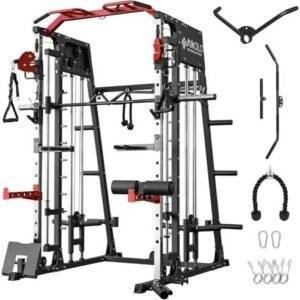Choosing the Best Ankle Weights for Workouts: Essential Guidelines
In a world where fitness enthusiasts are constantly seeking innovative ways to enhance their training routines, ankle weights have emerged as a versatile and effective tool for elevating workouts. Whether you’re aiming to boost endurance, increase strength, or add variety to your exercise regimen, selecting the right ankle weights is crucial to achieving your fitness goals while ensuring safety and comfort. With a range of options available on the market, understanding the key factors that influence the effectiveness and suitability of ankle weights can empower you to make an informed decision. This article presents essential guidelines to help you navigate the selection process, covering aspects such as weight options, material quality, fit and adjustability, and the specific exercises best suited for ankle weight training. By equipping yourself with the right knowledge, you can optimize your workout experience and reap the benefits these weights offer.
Table of Contents
- Choosing the Right Weight: Understanding Your Fitness Level and Goals
- Material Matters: Evaluating Comfort, Durability, and Safety Features
- Design Considerations: The Importance of Fit and Adjustability
- Effective Usage: Tips for Incorporating Ankle Weights into Your Workout Routine
- The Conclusion
Choosing the Right Weight: Understanding Your Fitness Level and Goals
Understanding your fitness level and workout goals is crucial when selecting the appropriate ankle weights. Beginners should consider starting with lighter weights, typically ranging from 1 to 2 pounds, to familiarize themselves with the movements and avoid injury. If you’re just diving into strength training or rehabilitation exercises, choosing weights that allow you to complete your sets with proper form is essential. Conversely, intermediate to advanced users may benefit from heavier weights, ranging from 3 to 5 pounds or more, to provide the additional resistance needed for muscle strengthening and endurance improvement.
Before purchasing, assess your specific objectives. Are you aiming to enhance muscle strength, improve endurance, or add variety to your cardio routine? Here’s a quick overview of considerations when selecting ankle weights:
- Fitness Level: Align weight selection with your current capabilities.
- Goals: Determine if you’re focusing on muscle toning, weight loss, or overall fitness.
- Comfort and Fit: Ensure that the weights are adjustable or come with secure straps for a snug fit.
To help you make an informed decision, here’s a simple table highlighting common ankle weight options:
| Weight | Ideal for | Example Exercises |
|---|---|---|
| 1-2 lbs | Beginners | Walking, leg raises |
| 3-5 lbs | Intermediate | Squats, lunges |
| 6-10 lbs | Advanced | High-intensity interval training (HIIT), plyometrics |
Material Matters: Evaluating Comfort, Durability, and Safety Features
When selecting ankle weights, it’s essential to consider the materials used in their construction, as this directly affects comfort, durability, and overall functionality. Look for weights made from breathable fabrics, such as neoprene or cotton blends, which provide a comfortable fit while absorbing moisture. Durable stitching and high-quality closures (like Velcro or straps) ensure the weights stay securely in place during your workouts, preventing any distractions or safety hazards. Additionally, consider the weight distribution; evenly distributed weights can enhance your stability and prevent strain on your joints.
Safety features are equally crucial when choosing ankle weights. Ensure the weights have a non-slip grip to keep them securely in place, minimizing the risk of injury during dynamic movements. It’s also important to opt for weights with reflective strips if you plan to use them outdoors, as these can enhance visibility in low-light conditions. Pay attention to any padding or cushioning incorporated into the design, as this can provide extra comfort and protection. When weighing your options, keep in mind how the product is constructed and the types of workouts you plan to engage in to find the best match for your training needs.
Design Considerations: The Importance of Fit and Adjustability
When selecting ankle weights, one of the most crucial factors to consider is how well they fit and how adjustable they are. A good pair of ankle weights should provide a snug fit without being too tight, ensuring that they stay in place during your workouts. Poorly fitting weights can lead to discomfort and distraction, diminishing the effectiveness of your exercise routine. Look for features such as adjustable straps or Velcro closures that allow you to customize the fit to your ankle size. This customization not only enhances comfort but also helps in preventing injuries caused by shifting weights during movement.
Moreover, the ability to adjust the weight itself can significantly impact your training efficiency. Many ankle weights come with removable weight bags that let you easily modify the resistance level as your strength improves. This adjustability is essential for a progressive workout regimen, allowing you to gradually increase the challenge without needing to invest in entirely new equipment. Consider the following aspects when assessing the fit and adjustability of ankle weights:
- Strap Material: Ensure it’s durable and breathable.
- Weight Distribution: Check that the weight is evenly distributed to avoid strain.
- Ease of Adjustment: Select models that allow quick changes in fit and resistance.
Effective Usage: Tips for Incorporating Ankle Weights into Your Workout Routine
Incorporating ankle weights into your workout routine can effectively enhance your strength training and cardio sessions. To maximize their benefits, start with a gradual introduction, allowing your body to adapt to the added resistance. It’s recommended to wear them during low-impact exercises such as walking, jogging, or body-weight movements like squats and lunges. This can help in building endurance and muscle tone. Here are some tips for effective usage:
- Begin with light weights, typically ranging from 1 to 3 pounds, especially if you’re new to using them.
- Focus on maintaining proper form; avoiding over-extension during movements is crucial.
- Distribute your workouts throughout the week, allowing adequate rest days to prevent strain.
Additionally, consider varying the exercises in which you include ankle weights to prevent plateauing and to target different muscle groups. You can wear them during pilates and yoga, enhancing the intensity of your routines. Remember to listen to your body; if you experience discomfort, it might be best to lighten the weights or reduce the duration of use. Below is a simple comparison table of exercises that can benefit from ankle weights:
| Exercise | Target Muscles | Recommended Weight |
|---|---|---|
| Walking | Legs, Glutes | 1-2 lbs |
| Squats | Quads, Hamstrings, Glutes | 2-3 lbs |
| Lateral Raises | Outer Thighs, Hips | 1-2 lbs |
The Conclusion
selecting the right ankle weights can significantly enhance your workout regime, offering both versatility and added resistance to your training. By considering factors such as weight distribution, material quality, adjustability, and comfort, you can ensure that your choice aligns with your fitness goals and personal preferences. Remember, the best ankle weights are those that not only challenge you but also support safe and effective movement. As you embark on your journey to improved strength and endurance, take the time to assess your needs, and invest in ankle weights that will help you achieve optimal results. With the right equipment, your workouts can become more dynamic and rewarding. Happy training!





